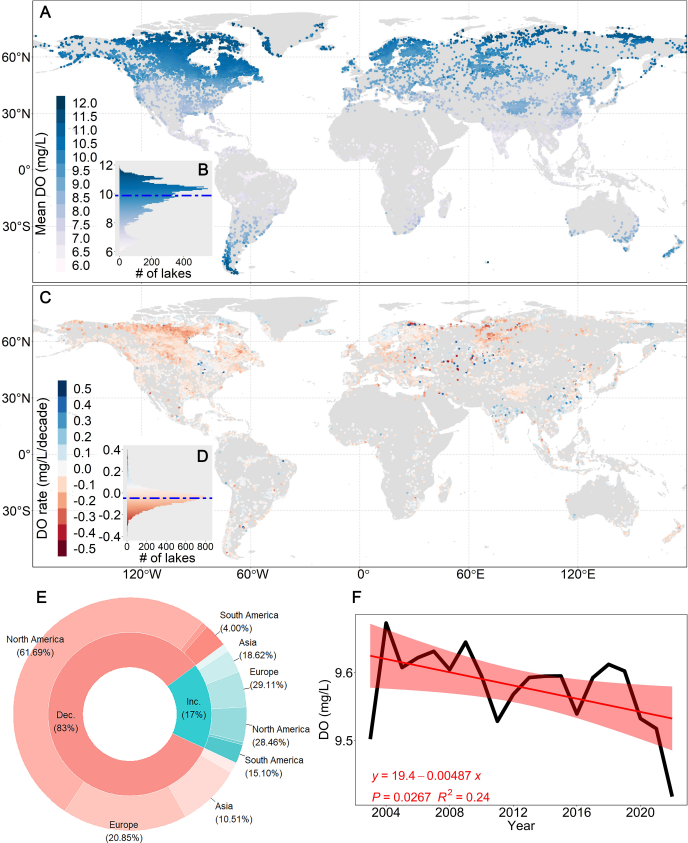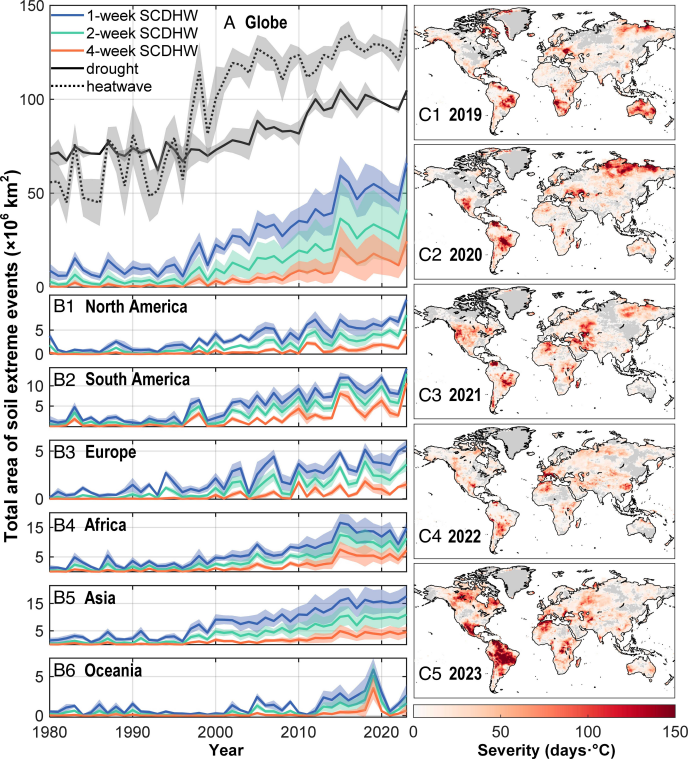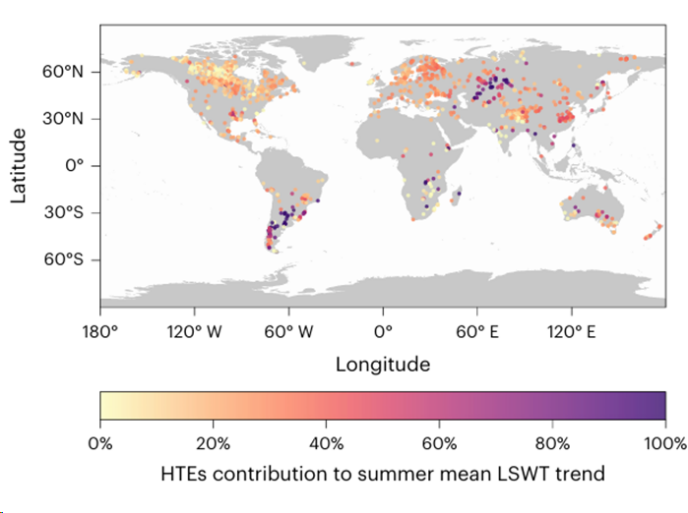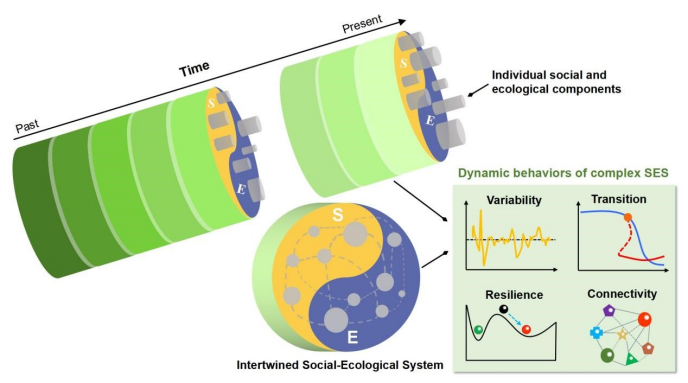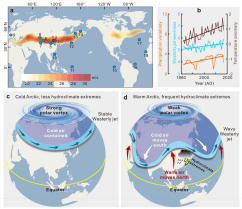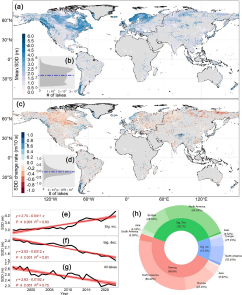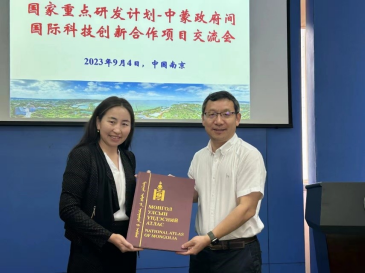Synergistic effects of warming and internal nutrient loading interfere with the long-term stability of lake restoration and induce sudden re-eutrophication
2023-02-27
Urban lakes are globally ubiquitous and are usually highly eutrophic, pointing to an increase in frequency, duration and magnitude of harmful algal blooms as wide-spread threats to ecological and human health.
Over half a century, phosphate (P) precipitation is among the most effective treatments to mitigate eutrophication in these lakes. However, after a period of high effectiveness, re-eutrophication would possibly occur leading to the return of harmful algal blooms. While such abrupt ecological changes were presumably attributed to internal P loading, the role of lake warming and its potential synergistic effects with the internal loading, thus far, has been largely understudied.
Researchers led by Dr. KONG Xiangzhen and Prof. Dr. XUE Bin from the Nanjing Institute of Geography and Limnology of the Chinese Academy of Sciences, along with their international collaborators, have addressed the question by quantifying the contributions of lake warming and the potential synergistic effects with internal P loading in an urban lake located in central Germany, which suffered from the abrupt re-eutrophication and cyanobacterial blooms in 2016 (30 years after the first P precipitation).
Their findings were published in Environmental Science & Technology on Feb. 20.
In this study, a process-based lake ecosystem model (GOTM-WET) was established using a high-frequency monitoring dataset covering eutro-/oligo-trophic states over 30 years.
Model analyses suggested that, for the abrupt occurrence of cyanobacterial blooms, internal P release accounts for 68% of the biomass proliferation, while lake warming contributed to 32%, including both direct effects via promoting growth (18%) and synergistic effects via intensifying internal P loading (14%). The model further revealed that the synergy was attributed to prolonged lake hypolimnion warming and oxygen depletion.
“Our study exemplifies how process-based mechanistic modeling could help to tease apart important drivers of abrupt shifts and cyanobacterial blooms in lakes, particularly in an era of rapid global changes including climate change and human activities.” said Dr. Kong.
This study unravels the substantial role of lake warming in promoting cyanobacterial blooms in re-eutrophicated lakes. The indirect effects of warming on cyanobacteria via promoting internal loading need more attention in future lake research and management.
“Our findings will have far-reaching consequences for lake restoration and management as the nutrient targets we applied so far to reach or maintain a certain trophic state will not work in a far warmer future and need to be adjusted, i.e. stronger nutrient level reduction and higher efforts in restoration are demanded.” said Dr. Kong.
link: https://pubs.acs.org/doi/10.1021/acs.est.2c07181
Contact
TAN Lei
Nanjing Institute of Geography and Limnology
E-mail: ltan@niglas.ac.cn
Sediment organic matter properties facilitate understanding nitrogen transformation potentials in East African lakes
2022-10-20
East African lakes include the most productive and alkaline lake group in the world. Yet, they generally receive fewer nutrient inputs than the densely populated subtropical and temperate lakes in the northern hemisphere. In these lakes with insufficient supplies of inorganic nitrogen, the mineralization of benthic organic matter can play an important role in driving the nutrient cycle and nitrogen loss. Using a suite of stable 15N isotope dilution and tracer techniques, we examined five main processes of the sediment nitrogen cycle in 16 lakes and reservoirs of Tanzania and Kenya, East Africa: gross nitrogen mineralization, ammonium immobilization, dissimilatory nitrate reduction to ammonium (DNRA), and the dinitrogen (N2) production via denitrification and anaerobic ammonium oxidation (anammox). Gross nitrogen mineralization and ammonium immobilization showed the maximum values of 9.84 and 12.39 μmol N kg-1 h-1 , respectively. Potential DNRA rates ranged from 0.22 to 8.15 μmol N kg-1 h-1 and accounted for 10 %–74 % (average 25 %) of the total dissimilatory nitrate reduction. Potential nitrate reduction rates in most lakes were dominated by denitrification with a contribution of 26 %–85 % and a mean of 65 %. We further found that the sediment nitrogen transformations were driven mainly by benthic organic matter properties and water column phosphate concentrations, reflecting microbial metabolic responses to the changing carbon and nutrients availability. For instance, autochthonous production of protein-like organic matter attributed to active sediment nitrogen mineralization, DNRA, and denitrification. In contrast, the high degree of humification caused by the inputs of terrestrial humic-like substances slowed down the sediment nitrogen transformations. The contribution of DNRA to total dissimilatory nitrate reduction was significantly positively correlated to sediment C: N ratios. These results indicate that predictions of sediment N supply and loss in East African lakes can be improved by incorporating sediment organic matter properties.
Xiaolong Yao, Zhonghua Zhao, Jianjun Wang, Qiqi Ding, Minglei Ren, Ismael Aaron Kimirei, Lu Zhang, Sediment organic matter properties facilitate understanding nitrogen transformation potentials in East African lakes, Science of The Total Environment, 841, 2022, 156607, https://doi.org/10.1016/j.scitotenv.2022.156607.
A comprehensive evaluation of organic micropollutants (OMPs) pollution and prioritization in equatorial lakes from mainland Tanzania, East Africa
2022-05-17
A lack of understanding the fate of highly toxic organic micropollutants (OMPs) in the equatorial lakes of Tanzania hinders public awareness for protecting these unique aquatic ecosystems, which are precious water resources and stunning wildlife habitats. To address this knowledge gap, the occurrence of 70 anthropogenically-sourced OMPs, including phthalates (PAEs), polycyclic aromatic hydrocarbons (PAHs), polychlorinated biphenyls (PCBs) and organochlorine pesticides (OCPs), was investigated in the water and sediment of 18 lakes in Tanzania. Similar residue concentrations were found in both compartments, showing higher pollution of PAEs ranging from 835.0 to 13,153.1 ng/L in water and 244.6–8691.8 ng/g dw in sediment, followed by PAHs, while OCPs and PCBs were comparatively lower. According to the multi-criteria scoring method for prioritization, the final OMP priority list for the lake environment in Tanzania comprised 25 chemicals, specifically 5 PAEs (DEHP, DIBP, DBP, DCHP and DMPP), 6 PCBs (PCB153, PCB105, PCB28, PCB156, PCB157 and PCB167), 6 PAHs (BaP, BaA, BbF, Pyr, DahA and InP) and 8 OCPs (cis-chlordane, trans-chlordane, p,p’-DDD, p,p’-DDE, p,p’-DDT, endrin, methoxychlor and heptachlor epoxide), suggesting the key substances for conventional monitoring and pollution control in these equatorial lakes, with an emphasis on PAEs, especially DEHP, due to the top priority and endocrine disruptor properties.
Zhonghua Zhao, Xiaolong Yao, Qiqi Ding, Xionghu Gong, Jianjun Wang, Saadu Tahir, Ishmael Aaron Kimirei, Lu Zhang, A comprehensive evaluation of organic micropollutants (OMPs) pollution and prioritization in equatorial lakes from mainland Tanzania, East Africa, Water Research, Volume 217, 2022, 118400, ISSN 0043-1354, https://doi.org/10.1016/j.watres.2022.118400.
Re-evaluation of Wetland Carbon Sink Mitigation
2022-03-22
A new review of coastal and inland wetland carbon sink services reveals current mitigation concepts for greenhouse gas emissions and measurements are not what they seem. Accumulation of buried organic carbon is not a measure of carbon sequestration; stable organic carbon inputs require subtraction and are undervalued; and carbon mitigation from wetland restoration is less than their preservation.
The study was published in the journal Wetlands as a flagship Mark Brison Review, from Nanjing Institute of Geography and Limnology, Chinese Academy of Sciences (NIGLAS) in collaboration with Borneo Marine Research Institute (BMRI) Universiti Malaysia Sabah (UMS), and lead by the Institute for Marine and Antarctic Studies (IMAS) University of Tasmania (UTAS).
Associate Reseacher Dr John Barry Gallagher (IMAS) said that the sediment organic carbon accumulation down inland and coastal wetlands has always been regarded as a convenient means of measuring trends and average rates of sequestration over climatic scales. Wetlands, however, are open to organic inputs from catchments and adjacent water bodies. These can be labile and easily consumed or decomposed, and recalcitrant outside the carbon loop that is not consumed or decomposed.
Consequently, what is required from the sediment record is not the total organic burial, but the burial rate of what remains of the wetlands plant production from the amount of the labile organics inputs consumed, and the remains of those recalcitrants inputs, largely black or pyrogenic carbon. To estimate this we modified a general decomposition model to hindcast the original input rate and to project what remains for all organic sources after 100 years of burial.
For a mangrove and a seagrass ecosystem, we found that carbon accumulation was on average 33.5 and 7.2 times greater than their respective sequestration rates. We also noted that sequestration relative to its non-canopy replacement or alternative stable state is not included for voluntary or compliance carbon markets, instead, only the rate of loss and gain of organic stocks for wetlands likely be disturbed or restored. This limitation would otherwise undervalue the wetlands systems mitigation potential with one caveat: the rate of gain in sediment stocks for a restored system is similarly constrained as a mitigation service by consumption and decomposition of those external organic inputs.
Dr Gallagher says that the review is important from two standpoints. Firstly, natural carbon sequestration solutions require re-evaluation. This is required to avoid GHG emissions above their capacity or indeed reduce the ability to fulfil Nations’emission targets, as set by COP26. Secondly, the model provides a new Paleoecological tool. It has the potential to measure and predict how wetlands' ability to function as a carbon sink can change with both climate and catchment agricultural and industrial development from changes to government policy.
Paper link: https://link.springer.com/article/10.1007/s13157-022-01539-5
More

